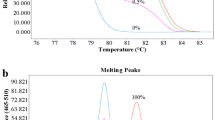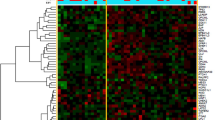Abstract
Background and Aim
Aberrant DNA methylation has been shown to be associated with the growth, development, metastasis, and prognosis of tumors. Methylated DNAs may be suitable biomarkers for cancer patients. Here, we investigated whether circulating methylated MINT2 DNAs represent a potential poor prognostic factor in gastric cancer (GC).
Methods
MINT2 methylation was detected by real-time methylation-specific PCR in tumor tissues, pairing preoperative peritoneal lavage fluid (PPLF) and blood from 92 GC patients. The theory meaning and clinical practicality value of MINT2 methylation in different specimens were analyzed.
Results
The methylation status of the MINT2 gene was found to be significantly higher in tumor tissues (44.6 %, 41/92) than in adjacent normal tissues (3.3 %, 3/92). No MINT2 methylation was found in healthy controls, and partial MINT2 methylation was observed in three (6.25 %, 3/48) patients with chronic atrophic gastritis. The frequency of MINT2 methylation in pairing PPLF and blood samples from 92 GC patients was 40.2 % (37/92) and 39.1 % (36/92), respectively. Methylated MINT2 in tumor tissues, pairing PPLF, and blood samples were very approximate. Aberrant MINT2 methylation in tumor tissues and pairing PPLF or blood samples were closely related to peritoneal dissemination, tumor progression, and poor prognosis (all P < 0.0001).
Conclusions
Aberrant MINT2 methylation in PPLF/blood may predict peritoneal micrometastasis for GC patients, which is a potential poor prognostic factor in GC.




Similar content being viewed by others
References
Bertuccio P, Chatenoud L, Levi F, et al. Recent patterns in gastric cancer: a global overview. Int J Cancer. 2009;125:666–673.
Khosravi Shahi P, Munoz Diaz, de la Espada VM, et al. Management of gastric adenocarcinoma. Clin Transl Oncol. 2007;9:438–442.
Wanebo HJ, Kennedy BJ, Chmiel J, Steele G, Winchester D Jr, Osteen R. Cancer of the stomach. A patient care study by the American College of Surgeons. Ann Surg. 1993;218:583–592.
Yoo CH, Noh SH, Shin DW, Choi SH, Min JS. Recurrence following curative resection for gastric carcinoma. Br J Surg. 2000;87:236–242.
Fujiwara Y, Doki Y, Taniguchi H, et al. Genetic detection of free cancer cells in the peritoneal cavity of the patient with gastric cancer: present status and future perspectives. Gastric Cancer. 2007;10:197–204.
Benevolo M, Mottolese M, Cosimelli M, et al. Diagnostic and prognostic value of peritoneal immunocytology in gastric cancer. J Clin Oncol. 1998;16:3406–3411.
Mori K, Suzuki T, Uozaki H, et al. Detection of minimal gastric cancer cells in peritoneal washings by focused microarray analysis with multiple markers: clinical implications. Ann Surg Oncol. 2007;14:1694–1702.
Asao T, Fukuda T, Yazawa S, Nagamachi Y. Carcinoembryonic antigen levels in peritoneal washings can predict peritoneal recurrence after curative resection of gastric cancer. Cancer. 1991;68:44–47.
Yamamoto M, Baba H, Toh Y, Okamura T, Maehara Y. Peritoneal lavage CEA/CA125 is a prognostic factor for gastric cancer patients. J Cancer Res Clin Oncol. 2007;133:471–476.
Da MX, Wu XT, Guo TK, et al. Clinical significance of telomerase activity in peritoneal lavage fluid from patients with gastric cancer and its relationship with cellular proliferation. World J Gastroenterol. 2007;13:3122–3127.
Nakanishi H, Kodera Y, Yamamura Y, et al. Rapid quantitative detection of carcinoembryonic antigen-expressing free tumor cells in the peritoneal cavity of gastric-cancer patients with real-time RT-PCR on the lightcycler. Int J Cancer. 2000;89:411–417.
Kodera Y, Nakanishi H, Ito S, et al. Prognostic significance of intraperitoneal cancer cells in gastric carcinoma: detection of cytokeratin 20 mRNA in peritoneal washes, in addition to detection of carcinoembryonic antigen. Gastric Cancer. 2005;8:142–148.
Ito S, Nakanishi H, Kodera Y, Mochizuki Y, Tatematsu M, Yamamura Y. Prospective validation of quantitative CEA mRNA detection in peritoneal washes in gastric carcinoma patients. Br J Cancer. 2005;93:986–992.
Wang JY, Lin SR, Lu CY, et al. Gastric cancer cell detection in peritoneal lavage: RT-PCR for carcinoembryonic antigen transcripts versus the combined cytology with peritoneal carcinoembryonic antigen levels. Cancer Lett. 2005;223:129–135.
Katsuragi K, Yashiro M, Sawada T, Osaka H, Ohira M, Hirakawa K. Prognostic impact of PCR-based identification of isolated tumour cells in the peritoneal lavage fluid of gastric cancer patients who underwent a curative R0 resection. Br J Cancer. 2007;97:550–556.
Tamura N, Iinuma H, Takada T. Prospective study of the quantitative carcinoembryonic antigen and cytokeratin 20 mRNA detection in peritoneal washes to predict peritoneal recurrence in gastric carcinoma patients. Oncol Rep. 2007;17:667–672.
Yu QM, Wang XB, Luo J, et al. CDH1 methylation in preoperative peritoneal washes is an independent prognostic factor for gastric cancer. J Surg Oncol. 2012;106:765–771.
Peng DF, Razvi M, Chen H, et al. Glutathione peroxidase 7 protects against oxidative DNA damage in oesophageal cells. Gut. 2009;58:5–15.
Lu XX, Yu JL, Ying LS, et al. Stepwise cumulation of RUNX3 methylation mediated by Helicobacter pylori infection contributes to gastric carcinoma progression. Cancer. 2012;118:5507–5517.
Ge MH, Chen C, Xu JJ, Ling ZQ. Critical regions and spreading of runt-related transcription factor-3 C-phosphate-G (CpG) island methylation in human salivary gland adenoid cystic carcinoma. Hum Pathol. 2011;42:1862–1872.
Ling ZQ, Zhao Q, Zhou SL, Mao WM. MSH2 promoter hypermethylation in circulating tumor DNA is a valuable predictor of disease-free survival for patients with esophageal squamous cell carcinoma. Eur J Surg Oncol. 2012;38:326–332.
Ling ZQ, Lv P, Lu XX, et al. Circulating methylated XAF1 DNA indicates poor prognosis for gastric cancer. PLoS ONE. 2013;8:e67195.
Charlet J, Schnekenburger M, Brown KW, Diederich M. DNA demethylation increases sensitivity of neuroblastoma cells to chemotherapeutic drugs. Biochem Pharmacol. 2012;83:858–865.
Hao Y, Chai KH, McLoughlin DM, Chan HY, Lau KF. Promoter characterization and genomic organization of the human X11β gene APBA2. Neuroreport. 2012;23:146–151.
Miller CC, McLoughlin DM, Lau KF, Tennant ME, Rogelj B. The X11 proteins, Abeta production and Alzheimer’s disease. Trends Neurosci. 2006;29:280–285.
Luebke T, Baldus SE, Grass G, et al. Histological grading in gastric cancer by Ming classification: correlation with histopathological subtypes, metastasis, and prognosis. World J Surg. 2005;29:1422–1427.
Tian XY, Zhu H, Zhao J, She Q, Zhang GX. Diagnostic performance of urea breath test, rapid urea test, and histology for Helicobacter pylori infection in patients with partial gastrectomy: a meta-analysis. J Clin Gastroenterol. 2012;46:285–292.
Lee S, Kim WH, Jung HY, Yang MH, Kang GH. Aberrant CpG island methylation of multiple genes in intrahepatic cholangiocarcinoma. Am J Pathol. 2002;161:1015–1022.
Hiraki M, Kitajima Y, Koga Y, et al. Aberrant gene methylation is a biomarker for the detection of cancer cells in peritoneal wash samples from advanced gastric cancer patients. Ann Surg Oncol. 2011;18:3013–3019.
Miyagawa K, Sakakura C, Nakashima S, et al. Overexpression of RegIV in peritoneal dissemination of gastric cancer and its potential as a novel marker for the detection of peritoneal micrometastasis. Anticancer Res. 2008;28:1169–1179.
Saito M, Nishikawa J, Okada T, et al. Role of DNA methylation in the development of Epstein-Barr virus-associated gastric carcinoma. J Med Virol. 2013;85:121–127.
Kondo T, Oka T, Sato H, et al. Accumulation of aberrant CpG hypermethylation by Helicobacter pylori infection promotes development and progression of gastric MALT lymphoma. Int J Oncol. 2009;35:547–557.
Acknowledgments
This research was supported by a grant from the program for New Century Excellent Talents in University, from the Ministry of Education, China (NCET-11-0949), a grant from the Science and Technology General Project of Zhejiang Province (No. 2009C33143), Key Research Projects of Medicine, from the Ministry of Health, China (No. WKJ2010-2-004), partly by a grant from the Backbone Talent of Zhejiang Provincial Medicine and Hygiene Platform Programs (No. 2011RCA009), a grant from the Scientific and Technological Innovations Fund of Henan Province Higher Education (No. 2009HAST1T001), and by a grant from the Science and Technology Key Project of the Ministry of Education, China (No. 210130).
Conflict of interest
None.
Author information
Authors and Affiliations
Corresponding author
Additional information
Jing Han and Ping Lv wish it to be known that, in their opinion, the first two authors should be regarded as joint-first authors.
Rights and permissions
About this article
Cite this article
Han, J., Lv, P., Yu, JL. et al. Circulating Methylated MINT2 Promoter DNA Is a Potential Poor Prognostic Factor in Gastric Cancer. Dig Dis Sci 59, 1160–1168 (2014). https://doi.org/10.1007/s10620-013-3007-0
Received:
Accepted:
Published:
Issue Date:
DOI: https://doi.org/10.1007/s10620-013-3007-0




